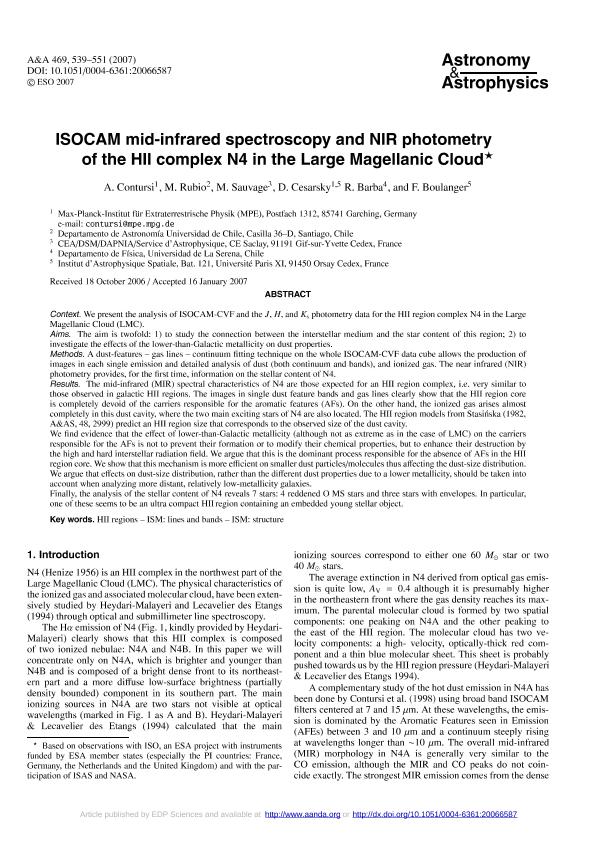Artículo
ISOCAM mid-infrared spectroscopy and NIR photometry of the HII complex N4 in the Large Magellanic Cloud
Fecha de publicación:
12/2007
Editorial:
EDP Sciences
Revista:
Astronomy and Astrophysics
ISSN:
0004-6361
Idioma:
Inglés
Tipo de recurso:
Artículo publicado
Clasificación temática:
Resumen
Context: We present the analysis of ISOCAM-CVF and the J, H, and Ks photometry data for the HII region complex N4 in the Large Magellanic Cloud (LMC). Aims: The aim is twofold: 1) to study the connection between the interstellar medium and the star content of this region; 2) to investigate the effects of the lower-than-Galactic metallicity on dust properties. Methods: A dust-features - gas lines - continuum fitting technique on the whole ISOCAM-CVF data cube allows the production of images in each single emission and detailed analysis of dust (both continuum and bands), and ionized gas. The near infrared (NIR) photometry provides, for the first time, information on the stellar content of N4. Results: The mid-infrared (MIR) spectral characteristics of N4 are those expected for an HII region complex, i.e. very similar to those observed in galactic HII regions. The images in single dust feature bands and gas lines clearly show that the HII region core is completely devoid of the carriers responsible for the aromatic features (AFs). On the other hand, the ionized gas arises almost completely in this dust cavity, where the two main exciting stars of N4 are also located. The HII region models from Stasińska (1982, A&AS, 48, 2999) predict an HII region size that corresponds to the observed size of the dust cavity. We find evidence that the effect of lower-than-Galactic metallicity (although not as extreme as in the case of LMC) on the carriers responsible for the AFs is not to prevent their formation or to modify their chemical properties, but to enhance their destruction by the high and hard interstellar radiation field. We argue that this is the dominant process responsible for the absence of AFs in the HII region core. We show that this mechanism is more efficient on smaller dust particles/molecules thus affecting the dust-size distribution. We argue that effects on dust-size distribution, rather than the different dust properties due to a lower metallicity, should be taken into account when analyzing more distant, relatively low-metallicity galaxies. Finally, the analysis of the stellar content of N4 reveals 7 stars: 4 reddened O MS stars and three stars with envelopes. In particular, one of these seems to be an ultra compact HII region containing an embedded young stellar object.
Palabras clave:
ISOCAM
,
Large Magellanic Cloud
,
HII complex N4
Archivos asociados
Licencia
Identificadores
Colecciones
Articulos(ICATE)
Articulos de INST.D/CS ASTRONOMICAS D/LA TIERRA Y DEL ESPACIO
Articulos de INST.D/CS ASTRONOMICAS D/LA TIERRA Y DEL ESPACIO
Citación
Contursi, A; Rubio, M.; Sauvage, M.; Cesarsky, R.; Barba, Rodolfo Hector; et al.; ISOCAM mid-infrared spectroscopy and NIR photometry of the HII complex N4 in the Large Magellanic Cloud; EDP Sciences; Astronomy and Astrophysics; 469; 2; 12-2007; 539-551
Compartir
Altmétricas




